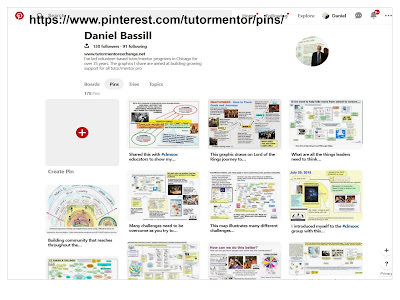You may have read what I just wrote, but did you understand it the way I hoped you would?
I've been creating visualizations since the 1990s to try to create a shared understanding of the ideas and strategies that I was producing via the Tutor/Mentor Connection, and the single youth tutor/mentor program I was leading in Chicago.
These are embedded in almost every article that I've written on this blog since 2007 and in PDF essays I started creating in the late 1990s. You can also see them in print newsletters from the 1990s. Below is a screen shot from my page on Pinterest, showing how I've aggregated some of my graphics on that site.
You can also do a web search for "Tutor/Mentor Connection" using Google or another platform, then look at the images feature. Many of the images you'll see were created by myself, or one of the interns who worked with the Tutor/Mentor Connection between 2006 and 2015. You'll see maps that date back to 1994, created by volunteers and part time paid staff (when money was available for this).
One of the graphics you'll find is the one at the right, created by an intern from South Korea in 2011. In this article you can see the original version of this graphic, created in the 1990s to visualize the T/MC's goal of connecting a growing number of people to information they could use to help individual tutor/mentor programs grow in all high poverty areas of Chicago, and to help each program constantly innovate better ways to help youth move through school and into adult lives.
On LinkedIn this morning I found a video by Marv Weisbord, a business consultant, that talks about evolution of business problem solving process since early 1900s. In the last eight minutes he talks about "getting everyone in the organization in a room to make a chart on the wall showing everything that has to happen for this system to improve."
He describes a point in the problem solving process where a problem is identified that no one in the room has a solution for. He says, "They stop the process and ask "Well, who knows?" Then go out to try to find that person."
He concludes the video describing the evolution of group dynamics, or "getting everyone involved to improve the whole" and talking about how important this is in trying to solve some of the complex problems facing the world in coming years.
 |
| Read 11/14 article |
At some point a question arises that has never been asked before. Then someone might say, "I'll do the research, and when I find an answer, I'll bring it to you."
I saw the Tweet below on my Twitter feed.
Check out the #DSMTweCon network analysis and related hashtags that have been used. You can see the variety of disciplines being discussed. @SocioVizNet pic.twitter.com/N3Zc3Yr32m— DSMOtago (@DSMOtago) July 25, 2018
When Marv Weisbord, or anyone else, talks about "getting everyone in the room" I'm asking, "how do you know who is in the room, or who is missing?"
 |
| One Section of T/MC Library |
In my introduction I wrote that I started creating visualizations because I feel that people who listen to what I say, or read what I write, have a mental picture, based on their own experiences, that may be different than what I'm trying to communicate.
Below is a presentation I created in early 2000 as "No Child Left Behind" was becoming the national education policy of the USA. It illustrates how people have different mental pictures when the words "tutor and mentor" are used. Creating a shared understanding is one step toward building solutions and long-term commitment to implementing those solutions.
Defining Terms. Tutoring. Mentoring. by Daniel F. Bassill on Scribd
I have been involved in this work for more than 40 years and have spent part of the past 25 years focusing on ways to get more people involved in helping build and sustain mentor-based youth and workforce development programs in all high poverty areas.
I've built a huge library of ideas. I've created several hundred visualizations, like this "village" graphic, representing the range of people who I feel "need to be in the room" innovating ways to reach kids in every high poverty neighborhood with a range of actions that help each one move safely and successfully through school and into adult lives.
 |
| "It takes a Village to Raise a Child" - who is helping? |
In the final portion of his video, Mr. Weisbord talks about "creating images of potential" rather than focusing on what's wrong, and how to fix it.
Maybe my maps and graphics are "images of potential". What do you think?
I've never had enough resources and talent to ask and answer all of the questions that need to be asked, or to mobilize more than a few of "all" who need to be involved.
I'm now looking for a way to share what I've learned in a consulting role, or through partnerships with one or more universities who might carry this work forward in future years. If you're interested in helping, or having a conversation, just reach out to me with a comment, or by connecting with me on Twitter, Facebook or LinkedIN.









































